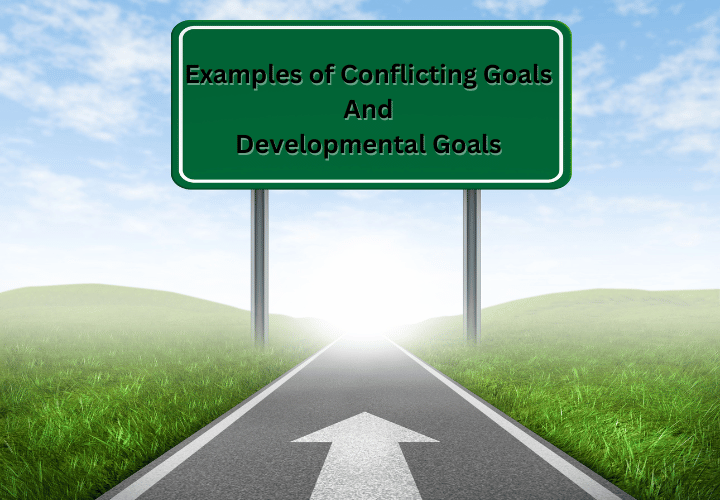No matter personal or professional life, tasks are part of a human’s daily routine. And, often, individuals might find it hard to balance or organize the objectives, since they don’t necessarily relate to one another. Those characterize conflicting goals.
Due to the diversity of motivation and personality, conflict is inevitable. At least once in our lives, we will be obligated to deal with personal and professional dilemmas.
Conflicts are an important part of life, occasionally growth comes from difficult times. Although, it is not uncommon to see psychological distress caused by the struggles in goal pursuit.
The mishandling and the settling of different goals lead to wear and overwhelm, impeding the achievement of the objectives.
Are you torn between two goals?


Imagine the scenario: your boss requires you to manage an urgent project; although, at the same time, you need to train 10 new staff members. Both tasks are required to be accomplished up to the end of the week. Sounds busy, right?
Clearly, the 8 to 10 hours a person spends at work — whether working from home or in-person — are not enough to complete all tasks set. There’s the option to try doing non-related goals at once or intercalating, but surely the result will be, at best, mediocre.
To deal with a busy to-do list, one requires disposing of energy and time. Beyond: it requires a great level of organization and time-management is needed, either work-from-home or in-person.
The act of being torn between two goals is called “conflicting goals”.
What are conflicting goals?
Conflicting goals are characterized by two — or more — goals to be achieved, but barely impossible to handle simultaneously since they conflict. In the workplace, conflict between tasks happens when superiors set multiple goals that do not match between them.
Various factors beyond time — such as budget, resources, or interpersonal relationships — cause negative impacts on employees’ psychological well-being and performance when mishandled.
Incompatible goals do not affect only the workspace, they can also affect the personal sphere. Sometimes, both spheres interfere with each other, causing impediments.
For a better understanding, let’s take a look at some examples of conflicting goals that affect performance.
What are some examples of Conflicting Goals?
Sometimes in life, superiors might allocate incompatible tasks that are incompatible between them and might sound illogical. It might be considered practical by employers, but delegating work that is incompatible with the main function of a worker also causes goal conflict.
Another possible situation might be an incompatibility between your work and your own values.
Some examples in the workplace might include:
- Leaving the marketing of an enterprise for an accountant can disturb their schedule.
- Managers willing to boost sales, meanwhile increasing product pricing.
- A translation agency sends a vegan person to translate a cattle catalog for a meat industry company.
Of course, these are only examples of conflict goals that might happen in one’s life. But not always is that complicated, sometimes it is just a matter of personal organization. The conflict and facilitation of tasks depend on the scenario you are inserted into.
Understanding Conflicting Goals and Goal Conflict
Although the terms might seem similar, there’s a slight difference between them.
While conflicting goals refer to the mismatch of tasks given by managers/superiors; goal conflict refers to general conflicts found in the workspace that impede the fulfillment of tasks.
Much research is done upon this organizational issue, since it directly affects employee’s responsive actions at work.
Goal conflict defined
Goal conflict characterizes the act of setting conflicting goals for a team. It might arise if two different leaders don’t properly communicate with each other. It impacts on work efficiency, possibly causing a delay in proper result delivery.
The interdependency of goals among teams of an enterprise requires a higher level of attention. At last, the attainment of the competing goals may depend on the same system, budget, resources, and workers.
Studies have shown that there are 3 types of goal conflicts:
- Approach-approach
- Approach-avoidance
- Avoidance-avoidance
Common sources of goal conflict
No matter if a leader or an employee, being attentive to the reasons for goal conflict offers a better understanding of how to deal with and prevent them in future occasions.
- Time: The uncertainty of your available time causes unnecessary stress and confusion, mainly when involving long-term tasks. The time you have must be well-settled and must be used wisely.
- Balance: Multiple goals simultaneously asked for employees are inevitable. However the absence of knowledge on how to manage all the to-do lists results in reduced work quality and might, in a worse scenario, result in missed due dates.
- Values: it is difficult to give up on personal values to embrace organizational values. But surely it is unnecessary. But if employees don’t comply with the company’s objectives, rarely the result will be satisfying.
- Relationship: Different values, opinions, personalities, and perspectives might lead to disagreements between teammates. Oppositions are positive, they lead to brainstorming and new — or even better — ideas.
However, the unhealthy discussions and disagreements may be offensive, bursting the professional environment and invading the personal sphere. The feud caused by a leak of alignment of thoughts and points of view prejudices the development of goals.
- Resources: It sounds uncommon, but many conflicts occur due to bad management and distribution of resources for teams. The result? Unnecessary rivalry among employees to show to be useful in order to achieve resources. Unfortunately, the competition might be detrimental to others’ goals.
Managing Conflicts Between Two Developmental Goals


So far, it is clear that poor self-management skills and organization result in lower performance — and, in the long-term, a dismissal. However, some useful abilities might come to light when striving for conflicting goals — in that case, turning them into development goals.
Developmental goals are meant to enhance skills, knowledge, and abilities for better results in professional and personal life.
Segerstrom and Solberg Nes (2006), affirm in a study that progress at goal achieving was noticed in individuals who pursued highly valued — even though conflicting — goals.
Even so, it is important to have practical solutions that might assist future projects and guarantee proper development and subjective well-being.
Prioritizing your goals
Consider visually defining your goals with all the details available. Make sure to have a good overview of your tasks. It will ease the process of defining the next step.
Then, you should be able to define your priorities. The best way to decide is to set an order of importance: deadline, difficulty level, urgency… You might also consider the benefits of each goal on a long-term basis.
Some useful organizational tools are available to assist daily management of aims, such as the Eisenhower matrix, value ladder, and SWOT.
Finding compatibility between goals
Finding an intersection between two conflicting goals simplifies the beginning of the next task; or even saves some work and energy.
To favor the process, try to separate the big tasks into smaller ones. Therefore, you will be able to find a common point between two divergent chores that might solve part of both goals in one single movement.
Making trade-offs
When you have your priorities resolved, you already know that some tasks might not be completed. And that is fine. Those are simple minor sacrifices and choices made in daily life.
Sometimes superiors set some higher level or unrealistic goals that depend on unavailable resources, budgets, and time. Clearly, it is not possible to expect an outstanding result from nonviable aims.
In those cases, it is possible to have trade-offs. Giving up on a high-level goal in order to achieve other ones that will also benefit you. E.g.: investing the available budget in a new company’s product instead of the marketing campaign for it, so the product will be well-planned.
Striving Towards Progress Despite Conflicting Aims


Conflicts are a big certainty in life, mainly in corporate management. But, as pointed out, conflicts can also bring progress when properly handled.
After all, every enterprise has internal organizational issues, even the most successful and known ones. The key to overcoming the negative effect of goal conflict is knowing how to work your way up out of them.
Staying focused on your vision
Be sure to have in mind the primary reason for that goal’s existence. Stay focused on the result you envisioned and go for it. Make sure to guarantee your team strives for the same results as you do.
For that, engage in discussion when necessary to clarify doubts and problems that may appear and cause issues for the progression of the job.
Be aware of what should be done, the time you have available, the deadline for each goal, and the applicable resources for it. Consider implementing the SMART method to enhance your vision and make it achievable!
Breaking goals into smaller steps
Goals tend to be easier when they are simplified, and a wise way of doing it is by dividing them into smaller pieces.
This strategy assists you in understanding what exactly needs to be done in order to achieve the desired result. But beware: Set realistic steps and certify that each of them has a reasonable time limit.
Being flexible
Even with brilliant planning, it is barely impossible to predict unexpected future events.
Be conscious that the relationship between goal conflict and teamwork exists and must be taken into account. Someone else’s task might interfere with yours, obligating you to rethink your plans and objectives.
You must expect the unexpected. Know that unplanned things might happen and you must be prepared to deal with the abrupt change of conditions. For an efficient goal striving, you must know how to reshape your tasks, to attend to new demands on current work.
Surely, you can try to forecast the unpredicted events. Studying future possibilities, at a certain level, can assist you to be prepared to deal with them. Try writing down possibilities; this simple activity may give you security and planning.
Research on Affective Consequences of Goal Conflict


So far, it is clear that with the right planning, you will mostly succeed in achieving your settled goals and improving the enhancement of your work. However, a lack of self-discipline is not the only impediment to a great job.
According to classic and contemporary theories, motivational inhibitory effects associated with goal conflict arise from the lack of resources of the person holding those goals.
Considering the fact that a good state of mind may define the success or failure of a project; it is important to understand how to keep the spirits up. However, not all negative impacts emerge from inner issues. Sometimes, demotivation can arise from the disorganization of higher positions.
After a study of many contemporary theories of motivation, we reunited three practices that may assist the morale of the team and prevent negative emotions associated with the workplace.
Learning to balance priorities
Keep track of your daily schedule to have a clear perspective of your duties. Be sure that each goal of your list is realistic; otherwise, you might face exhaustion, disappointment, and frustration.
You might want to categorize them: as critical for those that are highly valuable and require urgency, and low for things that are not urgent or are too small to be important.
It is interesting to consider doing the minor tasks first. By doing so, you can save your energy for the demanding tasks. Luckily, the minimal and time-consuming tasks intersect somehow, which usually saves time and reduces power struggle.
Building commitment
A major responsibility for motivation is commitment. To feel committed to a cause, first people need to feel part of the solution. Belonging and fulfillment must be worked through the team.
The employees must choose to commit to the company’s vision. This leads to effectiveness and proactivity since they will tend to pursue activities to benefit the company — at last, the enterprise’s success is the employee’s success.
However, this measure won’t lead anyone to constructive actions if leaders do not show support to workers.
Commitment requires a lot of trust and belief from workers. There must be reasons for committing, such as rewards (or the feeling of being rewarded), the appraisal of an employee’s work, and recognition of individual and collective achievements. Otherwise, the enterprise won’t have the positive result expected, badly reflecting on the team morale.
Developing creativity & problem-solving skills
When facing problems, you will need to come up with solutions. However, it is not a simple task.
Maybe you already had to rethink a solution of yours. Maybe you got it right the first time. But you most probably struggled with thinking of an effective problem-solving solution that attended to every demand you had.
No matter an accountant or a teacher, creativity is a resourceful ability needed in daily life. Because obvious answers are not always the best option. You must be inquisitive, and understand all scopes affecting your problem. Only after that you will be able to explore valid solutions for your questions.
Goals May Be Developed for One Person But Not Another
The reasons for a goal to exist vary with individual needs, desires, aims, demands, and economic reasons. “Development” varies in its meaning according to each person.
Here lies the importance of aligning goals and understanding that sometimes they most probably will diverge. A prejudicial action may be considered development on one side. So understanding and dealing with deception is part of the building of a healthy and functional environment.
Accepting goal conflict as normal
Since you get a job until the last day of your life, you will face challenges. Conflicts are inevitable, thinking otherwise is unproductive.
By acknowledging that individual priorities and objectives vary, mainly in a dynamic and diverse workspace, you might reduce the emotional impact of these situations. Besides, understanding people’s reasons behind actions surely will help you deal better with interpersonal relationships.
Focusing on strengths & opportunities
Instead of fixating on conflicts, be aware of the opportunities that might be hidden in the hard times. Taking into account your skills, abilities, and positive work aspects is a more productive way to strive for success.
Focusing your energy and productivity on your strengths contributes to teamwork; but also improves your skills and demonstrates value for your work.
Maintaining self-confidence
As important as recognizing your positive traits and skills, is being secure about them.
Insecurity and self-doubt undermine progress and might lead to a negative self-sabotage cycle. Instead, write down your strengths and visualize the positive aspects of yourself. It might sound like a simple attitude to take, but when you feel confident about yourself, others are most likely to trust you.
Solving conflict goals is not always a straightforward task. It requires plenty of discipline and collaboration from every employee and leader.
Even though struggling with tasks, it is important to keep finding alternatives for your problems. And when everything is settled and done, you may be surprised at the development you and your team have conquered.



